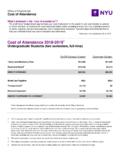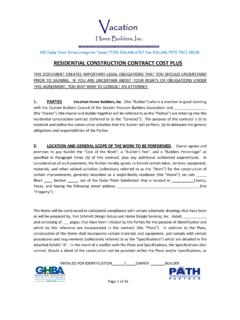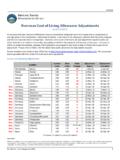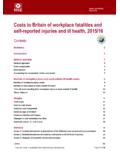Transcription of Cost-effectiveness analysis of cataract surgery: a …
1 338 Bulletin of the world health organization | May 2004, 82 (5)Objective To estimate the population health effects, costs and cost effectiveness of selected cataract surgery interventions in areas of the world with different epidemiological effectiveness estimates are based on a review of the literature taking into account factors such as operative failure, complications and patient non-compliance. A population model was applied to follow the lifelong impact on individuals having cataract surgery . Costing estimates are based on primary data collected in 14 epidemiological subregions by regional costing teams and on a literature review.
2 Costings were estimated for different geographical coverage levels using non-linear cost Intra- and extra-capsular cataract surgeries are cost -effective ways to reduce the impact of cataract -blindness. Extra-capsular cataract surgery is more cost -effective than intra-capsular surgery in all regions considered. Providing extra-capsular cataract surgery to 95% of those who need it (95% coverage level) would avert over million disability-adjusted life years (DALYs) per year globally. The Cost-effectiveness ranges from 57 International dollars (I$) per DALY in the WHO South-East Asia Region where there is high overall child and adult mortality to I$ 2307 per DALY in the WHO Western Pacific Region where there is low overall child and adult Extra-capsular surgery for cataracts at a high level of coverage is the most cost -effective way of restoring sight in all epidemiological subregions considered.
3 Analysts from countries within a region are encouraged to further contextualize the results based on their own country s specific cataract extraction/economics/complications; Lens implantation, Intraocular/complications; Eyeglasses/utilization; Treatment outcome; Patient compliance; Disability evaluation; cost -benefit analysis ; cost of illness; Comparative study; Review literature; Meta- analysis (source: MeSH, NLM).Mots cl s Extraction cataracte/ conomie/complication; Implantation intraoculaire lentille/complication; Verres correcteurs/utilisation; Evaluation r sultats traitement; Observance prescription; Evaluation incapacit ; Analyse co t-b n fice; Co t maladie; Etude comparative; Revue de la litt rature; M ta-analyse (source: MeSH, INSERM).
4 Palabras clave Extracci n de catarata/econom a/complicaciones; Implantaci n de lentes intraoculares/complicaciones; Anteojos/ utilizaci n; Resultado del tratamiento; Cooperaci n del paciente; Evaluaci n de la incapacidad; An lisis de costo-beneficio; Costo de la enfermedad; Estudio comparativo; Literatura de revisi n; Meta-an lisis (fuente: DeCS, BIREME).Bulletin of the world health organization 2004;82 page 344 le r sum en fran ais. En la p gina 344 figura un resumen en espa iMTA (Institute for Medical Technology Assessment), Erasmus University Rotterdam, Netherlands; and WHO-CHOICE, Global Programme on Evidence for health Policy, world health organization , 1211 Geneva 27, Switzerland; Correspondence should be sent to this author at the latter UNICEF, Ouagadougou, Burkina Prevention of Blindness and Deafness, world health organization , Geneva, No.
5 03-002931(Submitted: 28 February 03 Final revised version received: 18 September 03 Accepted: 3 October 03) Cost-effectiveness analysis of cataract surgery : a global and regional analysisRob Baltussen,1 Mariame Sylla,2 & Silvio P. Mariotti3 IntroductionCataracts are a major cause of blindness and of severe visual impairment leading to bilateral blindness in an estimated 20 million people worldwide. In developing countries 50 90% of all blindness is caused by cataracts (1).A cataract is a clouding of the lens of the eye that causes loss of vision.
6 Although cataracts result from many conditions, the most frequent cause is the natural ageing process. Other causes include injury, chronic eye disease and other systemic diseases, such as diabetes (2). Cataracts can take from a few months to several years to develop and can affect both eyes at the same time, but they often develop at different rates. Sometimes the cataract stops developing in its early stages and vision is only slightly impaired. But if it continues to develop, vision is impaired, and treatment is necessary. surgery to remove the opacified lens is the only effective treatment for cataracts.
7 Neither diet nor medications have been shown to stop cataract formation. There are several possible ap-proaches for the surgical extraction of cataracts. In this paper we evaluate the cost effectiveness of two different surgical procedures delivered to 50%, 80% or 95% of those who need analysis can be undertaken in many ways, and there have been several attempts to develop methodological .345339 Bulletin of the world health organization | May 2004, 82 (5) Research Rob Baltussen et al. cataract surgery : a global and regional Cost-effectiveness analysis guidelines to make results more comparable.
8 WHO has developed a standardized set of methods and tools that can be used to analyse the societal costs and impact on the health of the population of current and new interventions at the same time (3, 4). The WHO-CHOICE (CHOosing Interventions that are cost -Effective) project is intended to provide regularly updated data-bases on the costs and effects of a full range of interventions to promote health and prevent disease, and to cure and rehabilitate. Additional information on the project is shown in Box 1 (web ver-sion only, available at: ).
9 Adopting this standardized approach to generalized Cost-effectiveness analysis allows comparisons to be made among a range of interventions relating to cata-racts as well as with interventions for other major health would be desirable to evaluate all possible combinations of interventions for every country in the world . In the case of some of the larger countries, it would be desirable to evaluate these combinations at a subnational level. No country has yet been Box 2. Regions used in this studyRegion Mortality stratuma Countries includedAfrica D Algeria, Angola, Benin, Burkina Faso, Cameroon, Cape Verde, Chad, Comoros, Equatorial, Guinea, Gabon, Gambia, Ghana, Guinea, Guinea-Bissau, Liberia, Madagascar, Mali, Mauritania, Mauritius, Niger, Nigeria, Sao Tome and Principe, Senegal, Seychelles, Sierra Leone, TogoAfrica E Botswana, Burundi, Central African Republic, Congo, C te d Ivoire, Democratic Republic of the Congo, Eritrea, Ethiopia, Kenya, Lesotho, Malawi, Mozambique, Namibia, Rwanda.
10 South Africa, Swaziland, Uganda, United Republic of Tanzania, Zambia, ZimbabweRegion of the A Canada, United States of America, Cuba Americas Region of the B Antigua and Barbuda, Argentina, Bahamas, Barbados, Belize, Brazil, Chile, Colombia, Costa Rica, Americas Dominica, Dominican Republic, El Salvador, Grenada, Guyana, Honduras, Jamaica, Mexico, Panama, Paraguay, Saint Kitts and Nevis, Saint Lucia, Saint Vincent and the Grenadines, Suriname, Trinidad and Tobago, Uruguay, VenezuelaRegion of the D Bolivia, Ecuador, Guatemala, Haiti, Nicaragua, Peru AmericasEastern Mediterranean B Bahrain, Cyprus, the Islamic Republic of Iran, Jordan, Kuwait, Lebanon, Libyan Arab Jamahiriya, Region Oman, Qatar, Saudi Arabia, Syrian Arab Republic, Tunisia, United Arab EmiratesEastern Mediterranean D Afghanistan, Djibouti, Egypt, Iraq, Morocco, Pakistan, Somalia, Sudan, Yemen RegionEuropean Region A Andorra, Austria, Belgium, Croatia, Czech Republic, Denmark, Finland, France, Germany, Greece, Iceland, Ireland, Israel, Italy, Luxembourg, Malta, Monaco.


















